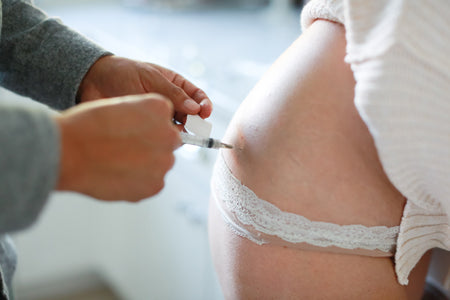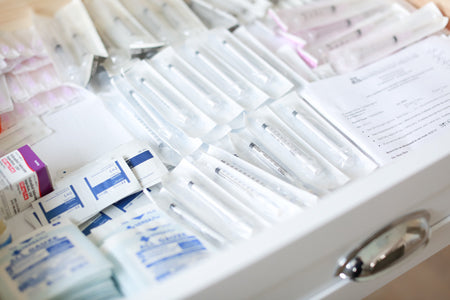My Cart(0)
IVF 101: The Basics

Your Emotions During IVF
Your emotions will be the hardest part of all of when going through an infertility treatment like IVF, and if you have been struggling with infertility for any amount of time, you already know this. One negative pregnancy test can feel like your heart is being ripped out of your chest, yet each month, you manage to put it back together and open that same heart up to the same exact thing that tore it up. Add a bunch of jacked up hormones to the mix, and then you are really feeling ALL the feels.
When we invest more money into our fertility treatments, the cost of our emotions goes up too, and as we just discussed, IVF ain’t cheap.
During this time, it’s incredibly important to find support. Whether it be a friend, an infertility group, or even a cyber buddy. You will need someone to help you through this time. I promise you that.
Many doctors believe that depression in infertile women is vastly comparable to the same levels of those suffering from heart disease or cancer. So if you are feeling any of this, know that it’s completely normal. I also want you to know that the more you survive, the more you will trust yourself to survive whatever is coming.
Take it from me, someone who has survived 5 years of treatment, and even a failed egg donor cycle. Your heart gets stronger. Your mind gets stronger. You get stronger.
It’s important to have a plan for either outcome, negative or positive. I always told myself before any procedure that I was going to believe it worked, because I could always cry later when I had a real reason to cry. This worked for me.
I would literally grab a bottle of booze and have it nearby before peeing on the stick, so that if the test was negative I put that bottle to the face fast and hard. And if it was positive, then my husband got to drink it. Make sure to have a few days to yourself open in your schedule for after testing. You will need time to process the results, good or bad.
Please take this part seriously, your mental state is very fragile during this time, and above all, YOU need to be cared for.

Infertility treatment is a big undertaking and your entire world will revolve around it, understandably so. You will learn an entirely new vocabulary - things like TTC, IUI, IVF, FSH, PUPO etc. The new lingo on it’s own can be overwhelming. You will learn things about reproduction that, if you are like me, never learned in Sex-Ed class. You will start noticing things about your body you never realized before, because quite frankly the texture of your discharge just wasn’t important until now.
You will have to work hard and contribute to your TTC plan every dang day - whether it be doctors visits 5-6 times in a two week period, setting 3-4 alarms a day to remember your injections, choking down 35 different supplements every night, sticking suppositories and other weird stuff up your coot-coot, and examining your panties for egg whites like a mother-effing panty hawk, infertility will be your life. Because if you want to become a parent, it has to be.
Here are a few basics to help you understand IVF better. Oh, and by the way, IVF stands for "In Vitro Fertilization", but I’m sure you’ve got that one down by now.
IVF 101: The Basics

Preparing for an IVF
Once you have decided to move forward with IVF (in vitro fertilization) you will need to start preparing. Your mind, your body, your schedule, your life. Especially if you want this to work, and I know you do.
-
Preparing your mind is one of the most important parts to this process. Start creating a peaceful place for the embryo to live.
- Meditate, take deep breaths, try acupuncture, diffuse and breathe in essential oils, take a walk on the beach.
- Start visualizing the baby growing inside of you. The hormones are going to try to tell you otherwise, but don’t listen to them. They will try to stress you out, make you anxious, and bring you down.
- Find a good meditation app or peaceful music to drown out those nasty thoughts. Have those ear buds on lock at all times!
- Your body will take a lot of preparation, and your doctor will direct you on very specific treatment of ovarian stimulation for approximately 10-12 days with the goal of maturing several follicles (ie. eggs).
- You will most likely be sticking yourself with needles during this time, so if you and your partner aren’t comfortable doing this, you will need to phone a friend. It’s important to stay organized and set alarms for your injections and medications.
- Our days can easily get away from us and it’s easy to miss one. And let me tell you, when you miss one, the guilt is real. Been there, done that.
- Many women like to prepare by gearing up with what I like to call “infertility armor” before going into battle. I sure did! Whether it be socks that say “hatch and attach”, a tank top with powerful infertility statement, or simply just rocking some fertility beads, find whatever makes you feel best going into your procedure. You are a warrior after all!
- Make sure to arrange your schedule accordingly. Some doctors require a 3-5 day bed rest after the transfer procedure. If that’s the case, make sure you have someone to help take care of you. My mom flew out and cooked me delicious meals during my bed rest, and I definitely think that contributed to my success! There are a lot of old wives tales about eating McDonald’s french fries and pineapple cores, but in my experience, Mama’s home cooking was all I needed!

The IVF Procedure
With IVF, there are actually two procedures. The retrieval and the transfer. If you are doing a fresh transfer, these two procedures will happen a few days apart, but if you are doing a frozen transfer, you will have plenty of time to schedule the second part. Once the doctor has determined that your eggs are mature, you’ll be asked to take one “trigger shot” in the arse that causes ovulation to happen exactly 36 hours later.

The Egg Retrieval
This is the more invasive of the two procedures, where you are hooked up to an IV, which is used to deliver a local anaesthetic and put you under. Using a needle attached to a catheter, the doctor will suction the mature eggs out of each follicle and store them in tubes, where they await fertilization. The procedure itself only takes about 15-20 min. You will be kept for a little while longer for recovery and will then go home.
The Egg Transfer
The retrieved eggs are then introduced to your partner’s (or sperm donor’s) sperm in a petri dish to do the dance and ultimately fertilize. Your male partner will likely need to be “on call” for this, if you know what I mean. A fertilized embryo (or two) is then implanted in your uterus, usually the MVP player is selected, and the rest of the team is frozen.
You will get a photo of your beautiful, chosen embryo prior to transfer, and then most clinics allow you to watch the process on a monitor in the exam room to see the process happening. If you are anything like me, prepare to get emotional! There is something really beautiful about the process of watching your baby be placed inside of you.
Increasing your Odds of IVF Success
When going the IVF route, you are likely faced with this dilemma - to genetically test your embryos or not? Genetic testing (otherwise known as PGS, preimplantation genetic screening) is when one more cells are removed from an IVF embryo to test for chromosomal normalcy, the genetically normal embryos are kept for transfer, and the abnormal embryos are discarded.

- The idea is that if you transfer genetically normal embryos you have a much better chance at getting pregnant, staying pregnant, and delivering a healthy baby without disease, disorder, or mutation. This is usually an optional step, however, some doctors are now requiring it. Mine did, and I’m glad he did. Implanting genetically normal embryos increases your odds of a positive pregnancy significantly. It also increases your odds of staying pregnant!
- It does cost extra to do this testing, but had we skipped this step, and implanted abnormal embryos that didn’t stick, we’d be shelling out extra expenses for additional IVF transfers, more medications and injections, more doctors visits, etc. not to mention the cost of our emotions having to go through that all over again. You can’t put a price on that.
The Costs of IVF
Spoiler alert - IVF aint’ cheap! Duh, y’all knew that. Everybody knows that, right? Average IVF costs are around $12k-$13k, however if you add in some of the “extras” the price goes up. Here are a few extras you may encounter….

- ICSI treatment – This is where a single sperm is injected directly into a mature egg, as opposed to placing many sperm together with the egg. This is typically done if there is an issue with the sperm, but some doctors, like ours, are using it as their go-to method. This could be an additional $1,500-$2k.
- PGS/PGD Testing – As noted above under “increasing your odds” is an additional cost, but in my opinion, good money spent. Depending on how many embryos you have tested, this could get pricey. The cost is determined per embryo, and from my experience could range from $300-$500 per embryo tested.
- Embryo freezing – Including the initial freezing and annual storage, this could cost an additional several hundred dollars. Yearly storage fees range anywhere from $200 to $800 per year. Think of it like paying rent for your babies.
- Additional Transfers: If you have additional frozen embryos and want to use them, doing so is significantly cheaper than doing a complete IVF cycle the first time with the retrieval costs. The average cost for a frozen embryo transfer (FET) is about $3,000 – $5,000.
- Egg Donor: If you plan on using an egg donor, like I did, the cost goes up significantly. I would plan on adding another $25k-$30k on top of the IVF cost. For our last, successful round with our egg donor, we ended up paying $45k all in, including the retrieval, meds for the donor and for me, the transfer, agency fees, legal, etc.
- Sperm Donor: Using a sperm donor is much less expensive than an egg donor, costing anywhere from $200 to $3,000 extra. It depends on how many vials you purchase, how much info you get on your donor, etc.
- Surrogacy: This is the MOST expensive add-on you can possibly encounter with IVF. If you include all the legal fees, agency fees, IVF costs, and payment to the surrogate, the cost can range anywhere between $50,000 to $100,000.
- Embryo donation: This is the least expensive of the donor options, where you are purchasing a fertilized embryo that already exists. An embryo donor cycle costs anywhere between $5,000 and $7,000.
The Physical Stuff
Infertility is physically challenging and exhausting. Your body takes a beating on a regular basis and you are left with bruises and sometimes lifelong scars. Fertility medications can cause weight gain, water retention, insomnia, pelvic pain, headaches, hot flashes, hormonal rage, etc. It’s an evil way of your body making you think you are pregnant, but soooo not.
The physical pain is hard, but remember, it’s temporary and your scars could be someone else’s sign of hope one day.

The Two Week Wait After Fertilization
After your IVF transfer, the waiting begins, and, it’s effing brutal. It’s termed the “two week wait” but some doctors will do the hCG blood test at 10-12 days after the transfer depending on the stage of your embryo when implanted. It might not seem like a long time, but when that’s ALL you can think about, it’s the longest two weeks of your life. It’s important to stay busy, and do things that keep your mind off it.
For me, I just decided that the moment that embryo was inside of me, I was pregnant. I’m an all or nothing kind of person, so I just acted like a pregnant woman. Even though I didn’t really have any “symptoms” yet, I still believed it was happening. It was my only option. I told myself that I could cry later if I had a reason to, but for now, I’m going to live in this joy. It was the only time I got to “be” pregnant and I was going to live it up!
Many women can’t hold out to the date of the blood test and end up peeing on a stick at home way before it’s time. The problem with this is that you could get false results and end up heart broken for no reason, or falsely excited. And remember, your primary job during this time is to create a happy, peaceful environment for that baby to snuggle in. Why stress yourself out for no reason?
I ended up peeing on the stick, but only 24 hours before my blood test, so I figured I was in the clear. I wanted the joy of seeing the two pink lines. Boy, was I glad I did this. I had NEVER seen two lines before this day, and we got to have our own moment, in the comfort of our own home, the way “normal” couples do it.

Getting The Results
After the two weeks, you will be scheduled for a blood test to determine if you are, in fact, pregnant. Typically the doctor will test you in the morning and call you with the results that evening. This blood pregnancy test is frequently called a “beta” because the test measures a beta chain portion of the human chorionic gonadotropin or hCG hormone emitted by the developing embryo and is officially named a “beta hCG” blood test.
A Positive Result:
If your beta test is positive, your doctor will tell you the hCG level that your test showed. The beta test result is stated as a number that indicates the level of hCG found in the blood and this number will increase pretty rapidly in healthy pregnancies, so multiple beta tests will be ordered over the next few days to confirm the pregnancy is proceeding normally.
You’ll repeat the test in 2 to 3 days. The goal is to have the level of hCG double every 3 days. If it does, another beta will be ordered for 2 to 3 days later.
If all three betas show a healthy pregnancy, then an ultrasound will take place between the 6 to 8 week mark of the pregnancy. At that time, your doctor will be looking for a heartbeat and a gestational sac to confirm the pregnancy. This is typically when the celebrating begins!
A Negative Result:
If you get a negative result on your beta test, no doubt, you will be crushed. Cry your eyes out if you have to. You have a reason to be sad. You are grieving another loss. Allow yourself the time to work through emotions and grieve before you decide what to do next.
- Sometimes this is a good time to take a break and reset.
- Others, will jump right back on the saddle the very next month.
- Find out what happened in your cycle that may have led to a negative. Be your own advocate and ask lots of questions about how you can improve your protocol for next time, should you continue.
Think of all the worse things in life that could be happening to you right now. I bet you can think of a lot, right? Be grateful you weren’t given one of those. Be grateful for all the other amazing things in your life that others dream of having. Accept that this is your struggle, and own it. It’s nothing to be ashamed of. It doesn’t define you. It is NOT your fault. You will survive this.
Fight on Warrior! Your baby is worth fighting for. You are a mother in the making. You are a warrior. I can honestly say, that after all we have been through, all the pain, the financial debt, the deep emotional sadness, I still wouldn’t change a thing.
My baby wouldn’t be the same person if I hadn’t experienced infertility, my marriage wouldn’t be as strong, and neither would I.
I survived infertility, and so will you.
About the author:
Victoria Nino is the creator of ExpectingAnything (an infertility blog and resource site) and ExpectingEverything (a pregnancy and parenting blog). She started her infertility blog merely as a means to cope with her own infertility through writing and with the hope to give other women a voice who need it. After almost five years of struggling to conceive, and multiple attempts at fertility treatments, she and her husband finally got pregnant via an egg donor IVF, and is “expecting” July 24, 2018. She keeps it 100% real and has a way of finding humor in the crappy things in life.
This Article was brought to you in collaboration with Bellefit, the makers of the best postpartum girdles
Founded in 2008 Bellefit® is the most mom-trusted and awarded brand of postpartum girdles corsets for recovery after c-section or natural childbirth. Bellefit® girdles come in five designs made using proprietary compression fabrics. Their unique design features triple-layered reinforced front and back support panels.
As a woman-owned company, Bellefit® is no stranger to the challenges new moms face during and after pregnancy. The company helps women feel supported and confident in their changing bodies.
Bellefit Girdles
unsubscribe at any time without costs.









